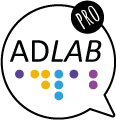Forthcoming or in press
Eardley, A. F., Fryer, L., Hutchinson, R., Cock, M., Ride, P. & Neves, J. (in press). Enriched audio description: Working towards an inclusive museum experience. In S. Halder, & L. Czop Assaf (Eds). Inclusion, disability and culture: An ethnographic perspective traversing abilities and challenges. Switzerland, Springer International.
Fryer, L. (forthcoming). Perception and psycholinguistics in AVT. In L. Perez Gonzales (Ed.), The Routledge handbook of audiovisual translation studies. London: Routledge.
Fryer, L. (forthcoming). Audio description, translation and pragmatics. In R. Tipton, & L. Desilla (Eds,), The Routledge handbook of translation and pragmatics. London: Routledge.
Perego, E. (forthcoming). Audiodescription. In. J. Perez Gonzales (Ed.), The Routledge handbook of audiovisual translation studies. London: Routledge.
Remael, A., & Reviers, N. (forthcoming). Multimodal cohesion in accessible films: A first inventory. In. J. Perez Gonzales (Ed.), The Routledge handbook of audiovisual translation studies. London: Routledge.
Walczak, A., & Fryer, L. (forthcoming). Vocal delivery of audio description by genre: Measuring users’ presence. Perspectives: Studies in Translatology.
2017
Walczak, A., & Fryer, L. (2017). Creative description: The impact of audio description style on presence in visually impaired audiences. British Journal of Visual Impairment , 35(1), 6-17.
Taylor, C. (2017) Reading images (including moving ones). In T. Bartlett, & G. O’Grady (Eds.) The Routledge handbook of systemic functional linguistics (pp. 575-590). London: Routledge.
2016
Dávila-Montes, J., & Orero, P. (2016). Audio description washes brighter? A study in brand names and advertising. In A. Matamala, & P. Orero (Eds.), Researching audio description new approaches (pp. 123-142). London: Palgrave Macillan.
Fernández-Torné, A., & Matamala, A. (2016). Machine translation and audio description? Comparing creation, translation and post-editing efforts. SKASE. Journal of Translation and Interpretation, 9(1), 64-87.
Fryer, L. (2016). An introduction to audio description: A practical guide. London: Routledge
Jankowska, A., & Szarkowska, A. (2016). Strategie opisu kulturemów w audiodeskrypcji. Między Oryginałem a Przekładem, 1(31), 137-152.
Jankowska, A., & Zabrocka, M. (2016). How co-speech gestures are rendered in audio description: A case study. In A. Matamala, & P. Orero (Eds.), Researching audio description new approaches (pp. 169-186). London: Palgrave Macmillan.
Mangiron, C. (2016). Reception of game subtitles: An empirical study. The Translator, 22(1), 72-93.
Mangiron, C. (2016). The use of the Catalan language in the video game industry. Treballs de sociolinguistica catalana, 26, 13-26.
Mangiron, C., & Zhang, X. (2016). Game accessibility for the blind: Current overview and the potential application of audio description as the way forward. In A. Matamala, & P. Orero (Eds.), Researching audio description new approaches (pp. 75-95). London: Palgrave Macmillan.
Matamala, A., & Orero, P. (2016). Audio description and accessibility studies: A work in progress. In A. Matamala, & P. Orero (Eds.), Researching audio description new approaches (pp. 1-8). London: Palgrave Macmillan.
Matamala, A., & Orero, P. (2016). Researching audio description. New approaches. London: Palgrave Macmillan.
Matamala, A., & Ortiz-Boix, C. (2016). Accessibility and multilingualism: An exploratory study on the machine translation of audio descriptions. Trans, 20: 11-24.
Orero, P. (2016). Audio describing the TV series The West Wing. InTRAlinea: Online Translation Journal, 18.
Orero, P. (2016). From DTV4ALL to HBB4ALL: Accessibility in European broadcasting. In A. Matamala, & P. Orero (Eds.), Researching audio description new approaches (pp. 249-267). London: Palgrave Macmillan.
Perego, E. (2016). Empirical research in accessible audiovisual translation: General remarks and a case study on audio description. In N. Maelzer (Ed.), Barrierefreie Kommunikation – Perspektiven aus Theorie und Praxis [Media Accessibility – Perspectives from Theory and Practice] (pp. 233-246). Berlin: Frank & Trimme.
Perego, E. (2016). Gain and losses of audio description in sighted viewers. Target 28(3), 424-444.
Reviers, N. (2016). Audio description services in Europe: An update. The Journal of Specialised Translation, 26, 232-247.
Szarkowska, A., Jankowska, A., Krejtz, K., & Kowalski, J. (2016). Open Art: Designing accessible content in a multimedia guide App for visitors with and without sensory impairments. In A. Matamala, & P. Orero (Eds.), Researching audio description new approaches (pp. 301-320). London: Palgrave Macmillan.
Taylor, C. (2016). The multimodal approach in audiovisual translation. In Y. Gambier, & S. Ramos Pinto (Eds.) Audiovisual Translation. Theoretical and Methodological Challenges. [Special issue] Target, 28(2), 222-236.
Chmiel, A., & Mazur, I. (2016). Researching preferences of audio description users — Limitations and solutions. Across Languages and Cultures 17(2), 271-288.
Mazur, I., & Chmiel, A. (2016). Should audio description reflect the way sighted viewers look at films? Combining eye-tracking and reception study data. In A. Matamala, & P. Orero (Eds.), Researching audio description new approaches (pp. 97-122). London: Palgrave Macmillan.
